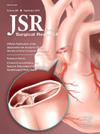谁会被推荐?甲状旁腺功能亢进获得专科护理的差异
IF 1.7
3区 医学
Q2 SURGERY
引用次数: 0
摘要
原发性甲状旁腺功能亢进(PHPT)与显著的患者发病率相关,包括骨折、肾结石和心血管事件的风险增加。甲状旁腺切除术仍然是一种未充分利用的治疗方法,特别是在历史上处于不利地位的人群中。我们试图更好地理解社会决定因素的关联,通过邻里优势来衡量,对PHPT诊断和治疗途径的特定步骤有更好地确定干预目标。方法回顾性分析了2021年1月1日至2023年1月1日期间所有年龄≥18岁且钙值升高(10.2 mg/dL)且未被诊断为PHPT、继发性或三期甲状旁腺功能亢进或肾衰竭的患者。采用区域剥夺指数对患者的邻里优势进行分层,形成弱势、中等、优势三个队列。比较重复钙检查、甲状旁腺激素(PTH)评估、专科转诊和甲状旁腺切除术的比率。结果共检出高钙血症患者6749例,其中3976例(58.9%)符合纳入标准。3646例(91.7%)患者进行了重复钙检查,仅872例(57.5%)患者进行了PTH检查。邻域优势对重复钙(P = 0.53)和甲状旁腺激素(P = 0.18)的评价没有差异。专家评价率(优等74.9%,中等66.3%,优等59.8%,P <;0.01)。结论转诊是导致PHPT治疗差异的主要原因。需要采取干预措施,解决个人和社区层面的障碍,特别是在从初级保健向专科保健过渡的过程中,以增加获得甲状旁腺切除术的机会,并进一步实现卫生公平。本文章由计算机程序翻译,如有差异,请以英文原文为准。
Who Gets Referred? Disparities in Access to Specialist Care for Hyperparathyroidism
Introduction
Primary hyperparathyroidism (PHPT) is associated with significant patient morbidity, including increased risk of fractures, nephrolithiasis, and cardiovascular events. Parathyroidectomy remains an underutilized therapy, particularly among historically disadvantaged populations. We sought to better understand the association social determinants, as measured by neighborhood advantage, have on particular steps of the diagnostic and treatment pathway for PHPT to better identify targets for intervention.
Methods
We performed a retrospective analysis of all patients ≥18 y of age with an elevated calcium value (>10.2 mg/dL), and without a prior diagnosis of PHPT, secondary or tertiary hyperparathyroidism, or kidney failure, between January 1, 2021 and January 1, 2023. Patients’ neighborhood advantage was stratified using the Area Deprivation Index to create three cohorts—disadvantaged, moderate, advantaged. The rates of repeat calcium check, parathyroid hormone (PTH) evaluation, specialist referral, and parathyroidectomy were compared.
Results
A total of 6749 patients with hypercalcemia were identified, and 3976 (58.9%) met inclusion criteria. Repeat calcium was checked for 3646 (91.7%) of patients, and PTH checked in only 872 patients (57.5% of patients with repeat hypercalcemia). There was no difference in repeat calcium (P = 0.53) or PTH evaluation (P = 0.18) by neighborhood advantage. Significant differences were noted in rate of specialist evaluation (74.9% advantaged, 66.3% moderate, 59.8% disadvantaged, P < 0.01).
Conclusions
Referral to specialist is the step that contributed most to disparities in treatment rates of PHPT. Interventions addressing both individual- and community-level barriers, particularly in the transition of care from primary care to specialists, are needed to increase access to parathyroidectomy and further health equity.
求助全文
通过发布文献求助,成功后即可免费获取论文全文。
去求助
来源期刊
CiteScore
3.90
自引率
4.50%
发文量
627
审稿时长
138 days
期刊介绍:
The Journal of Surgical Research: Clinical and Laboratory Investigation publishes original articles concerned with clinical and laboratory investigations relevant to surgical practice and teaching. The journal emphasizes reports of clinical investigations or fundamental research bearing directly on surgical management that will be of general interest to a broad range of surgeons and surgical researchers. The articles presented need not have been the products of surgeons or of surgical laboratories.
The Journal of Surgical Research also features review articles and special articles relating to educational, research, or social issues of interest to the academic surgical community.

 求助内容:
求助内容: 应助结果提醒方式:
应助结果提醒方式:


